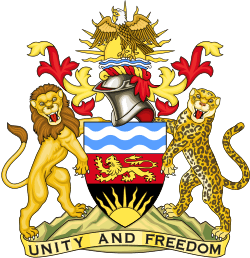Nyasaland general election, 1961
 |
| This article is part of a series on the politics and government of Malawi |
|
Government |
|
Legislature |
General elections were held for the Legislative Council in Nyasaland in August 1961. The result was a victory for the Malawi Congress Party, which won all 20 lower roll seats (in five of which they were unopposed)[1] and two of the eight higher roll seats.
Electoral system
There were two voter rolls, a lower roll with a predominantly African electorate, which elected 20 members, and had 106,095 registered voters, and a higher roll of largely European and Asian electors, which elected eight members, with 4,337 registered voters. As five constituencies in the lower roll were uncontested, only 75,707 voters were eligible on election day.[2] All members were elected from single-member constituencies, which largely followed the same boundaries as the country's districts.
| District | Lower roll electorate | Lower roll constituency | Higher roll electorate | Higher roll constituency |
|---|---|---|---|---|
| Karonga | 5,266 | Karonga | 32 | Northern Province |
| Mzimba | 13,802 | Mzimba North Mzimba South | 198 | |
| Nkata Bay | 5,643 | Nkata Bay | 30 | |
| Rumpi | 3,597 | Rumpi | 28 | |
| Dedza | 5,741 | Dedza | 82 | Central Districts |
| Dowa | 6,467 | Dowa | 82 | |
| Fort Manning | 4,087 | Kasungu Fort Manning | 23 | |
| Kasungu | 4,012 | 25 | ||
| Kota Kota | 4,285 | Kota Kota | 25 | |
| Ncheu | 4,368 | Ncheu | 43 | |
| Lilongwe | 9,649 | Lilongwe North Lilongwe South | 485 | Central Districts Lilongwe Town |
| Blantyre | 4,065 | Blantyre Urban | 2,036 | Blantyre Soche Limbe |
| 8,072 | Blantre Rural Chiradzulu | 82 | ||
| Chikwawa | 2,638 | Lower River | 28 | Southern Districts |
| Port Herald | 1,949 | 47 | ||
| Cholo | 4,754 | Cholo | 295 | |
| Mlanje | 7,654 | Mlanje | 191 | |
| Fort Johnston | 2,253 | Fort Johnston Kasupe | 48 | Shire North |
| Kasupe | 2,150 | 22 | ||
| Zomba | 5,643 | Zomba | 522 | |
| Total | 106,095 | 4,337 | ||
| Source: Constituencies Commission[3] | ||||
Results
| Party | Lower roll | Higher roll | Total seats | ||||
|---|---|---|---|---|---|---|---|
| Votes | % | Seats | Votes | % | Seats | ||
| Malawi Congress Party | 71,659 | 98.8 | 20 | 385 | 10.3 | 2 | 22 |
| United Federal Party | 607 | 0.8 | 0 | 2,108 | 56.6 | 5 | 5 |
| Christian Liberation Party | 272 | 0.4 | 0 | – | – | 0 | 0 |
| Independents | – | – | 0 | 1,232 | 33.0 | 1 | 1 |
| Total | 72,538 | 100 | 20 | 3,725 | 100 | 8 | 28 |
| Registered voters/turnout | 75,707 | – | 4,337 | – | – | ||
| Source: Nohlen et al. | |||||||
Aftermath
Before the elections, the Colonial Office had assumed that the Malawi Congress Party would be entitled to three Executive Council seats through winning a majority of the lower roll seats. As the Lancaster House agreement provided that two Executive Council seats would go to ministers elected from the higher roll, it was thought that the mainly white United Federal Party would gain both these seats. In the event, the United Federal Party only won five seats, two going to Congress and one to an Congress-inclined independent, Colin Cameron. The Governor offered the United Federal Party a single Executive Council seat, which it refused. This left all five elected Executive Council seats available for Congress candidates.[4]
Sources
- The National Archives (United Kingdom): File DO 158/36: "Malawi Congress Party"
- The National Archives (United Kingdom): File CO 1015/2444: "Malawi Congress party"
- Lucy Mair, The Nyasaland Elections of 1961 (London: Athlone Press, 1962)
References
- ↑ Nohlen, D, Krennerich, M & Thibaut, B (1999) Elections in Africa: A data handbook, p558 ISBN 0-19-829645-2
- ↑ Nohlen et al, p558
- ↑ Nyasaland Legislative Council Elections, 1961: Report of the Constituencies Commission Constituencies Commission, pp9-12
- ↑ J McCracken (2012) A History of Malawi, 1859–1966 Woodbridge, James Currey, pp381–52, 403–4, ISBN 978-1-84701-050-6